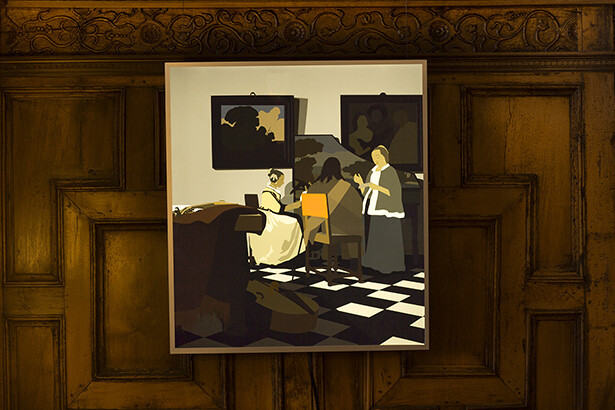Opening: Tuesday, February 14, 2017, 5:30–7:30pm
Mead Art Museum
Amherst College
41 Quadrangle Dr
Amherst, MA 01002
On Thursday, Februay 9, 2017, the Mead Art Museum at Amherst College presents Rotherwas Project 2: Kota Ezawa, Gardner Project Revisited. This exhibition in the Mead’s historic Rotherwas Room features representations of 13 artworks stolen from the Isabella Stewart Gardner Museum in Boston. More than 25 years ago, on March 18, 1990, two thieves posing as Boston police officers stole these works in the middle of the night. In his Gardner Project Revisited, Kota Ezawa has given the disappeared Gardner artworks new life in the form of dynamic and colorful drawings set in glowing light boxes. Included are Ezawa’s unique cartoon-like versions of paintings by Vermeer, Rembrandt and Manet, drawings and sketches by Degas, and a single antique Chinese vase. These stunning 21st-century reimaginings are displayed to scale in the 17th-century woodpaneled Rotherwas Room, along with an image of an empty frame left behind after the theft and Ezawa’s six-minute animated film of the security tape recorded the night before the largest unsolved art heist in American history.
Rotherwas Project 2: Kota Ezawa, Gardner Project Revisited is part of the second installment in a new exhibition series at the museum. Mead Reimagined immerses audiences in the dynamic relationship between contemporary and historic work with new gallery rotations in recently renovated spaces, offering a fresh perspective on the college’s art collection. The opening and reception for Mead Reimagined, Take 2, is February 9 from 5:30–7:30pm, and is free and open to the public.
The central mission of Mead exhibitions is to encourage deep and immediate visitor engagement with art spanning continents and centuries, in a variety of media. “The Mead’s flow of reinstallations are an opportunity to show the full breadth of our collection,” says David E. Little, Mead director and chief curator, “allowing us to engage students, professors, and the public to come to the Mead on a regular basis and find new gems and relationships of art on view.”
The Mead’s main exhibition space, Fairchild Gallery, has been transformed into a bright, expansive and contemporary space that now feature a video room, currently showing Peter Fischli and David Weiss’s enchanting short film The Way Things Go (1987). The exhibition Accumulations: 5,000 Years of Objects, Fictions, and Conversations showcases a selection of artworks and cultural objects from the Mead’s wide-ranging collection. It underscores how museum collections are built—partly by chance—through the accumulation diverse art from across the centuries, largely thanks to the individual collecting passions and generosity of supporters.
African, American, European, and Russian collections also on view
The remaining galleries feature curatorial reinterpretations of the Mead’s well-regarded holdings of African, American, European, and Russian art.
Art From Africa: A Selection of Works Given by Amherst Collectors and Scholars presents an array of African art, including many ritual objects used in divination rites in Central and West Africa. American art, the foundation of Amherst’s collection, is showcased in The American Collection: Two Centuries of Art at Amherst College. The founding of museums is also a theme of Precious: Finding the Wondrous in the Mead’s European Art Collection, organized by Nicola Courtright, William McCall Vickery 1957 Professor of the History of Art. The exhibition looks at how European princes, scholars, and merchants once gathered objects that fascinated them. From these private collections emerged museums as we know them today.
Russian art is the focus of From Russia With Love: Selections from the Thomas P. Whitney, Class of 1937, Collection of Russian Art. Thomas P. Whitney began amassing his collection while working as a foreign service officer in Russia during World War II. Late in the twentieth century, he gave most of the art, books, and manuscripts he had collected to Amherst College.
Contact: Danielle Amodeo, [email protected]

